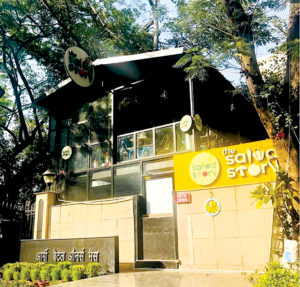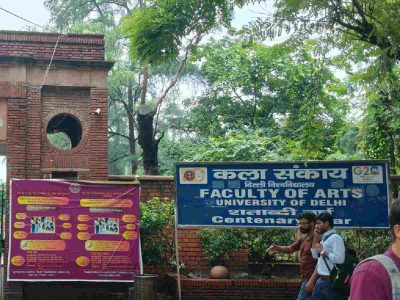Cafes are places you go to for a certain vibe, not just for coffee, snacks and health food. They are a step above campus canteens and a level below restaurants
Before joining Delhi University, Prakriti Arora would pay a visit to the nearest McDonald’s or Dominoes. On the first day of the college, she was introduced to the ‘DU Bible: A Survival Guide for Delhi University Students’. It listed the ‘cool’ places for students to hang out.
“It calls for you to visit QD’s restaurant,” recalls Arora. QD’s is a popular food restaurant chain in the Capital, with five outlets, serving from Chinese to North Indian cuisine. Unlike its name, QD’s is not precisely a restaurant but out-and-out a cafe. Among the Dilliwalas, it’s also quite popular for coming up with ‘Tandoori Momos.’
“I distinctly remember, on my first day of college, that’s where I went for lunch,” says Arora. Surprised by its vibe, Arora could make a clear distinction between the visits she paid to a restaurant with her parents, and the one that day. “The vibe was very chilled out, the people were loud, beaming with happiness for some reason,” she added.
Most cafes in the Capital have low-priced menus, giving students a good reason to frequent them, apart from the ethos. As life in college is very ‘outgoing’, they often decide to go some cafe in Hudson Lane (a lane in North Campus) – and choose another such outlet the next day.
While popular cafes like The Big Chill, QD’s, The Big Yellow Door, Echoes and Cha Bar have dominated the business, the Capital city is also seeing super niche cafes mushrooming lately.
Though a place for great coffee still remains relevant among city goers. Coffee Bond, which has five outlets in Delhi NCR, sees customers making a beeline for its coffee, which comes from an estate in Karnataka.
“We are now coming up with draught coffee too,” said the manager of the outlet in Greater Kailash.
Vatsla Srivastava was first introduced to the concept of a cafe during a holiday in Varanasi. “We went to this cute place which serves burgers and had beautiful interiors,” she said.
For Srivastava, cafes are more suitable for her when she has to pay on her own and prefers a fine dining experience when her parents are going to pay the bill.
She explored cafes in the Capital while studying in Delhi University. “That was all I did for the entire three years. A cafe is not a place where you need to have a company, you can just go there and sit by yourself,” said Srivastava.
Today, the first and foremost criteria for her is to see the food and aesthetics the cafe has to offer — “rather than checking the cost for two,” she adds.
Health Cafes are one such example of this ever-changing shift shaping the culinary character of the city, as more and more citizens continue to aspire to get fit. The concept of health cafes is essentially to serve customers with fresh salads to cold-pressed juices. These cafes have an extensive menu catering to the needs of gym goers.
One such establishment which sees an influx of dine-in and takeaway orders is The Salad Story in posh Khan Market. From meal bowls to an array of options in salads, the Salad Story is another success story in the business of health cafes. It has 10 outlets in Delhi and NCR
Honey, the manager, tells us that the outlet sees about 50-60 customers walking in every day to savour the salads, the number doesn’t change on weekends either. “There’s a huge demand for healthy food as people are tired of eating junk food, especially maida. The Salad Story is 100% maida free. We make our breads using whole wheat.” says the manager.
Listed on food aggregator Zomato too, The Salad Story gets business of 10-15 orders every day. He also gives an example of the outlet in Greater Kailash, and claims that the outlet gets 70% of its business each day, through online orders.
Ashish Gupta, opened the first health cafe in Gurugram named 3 And A Half , one of two outlets of Gold’s Gym. In 2012, when he opened his first gym, there was a huge empty space to spare.
“I’ve always had a passion for food. I was working with NDTV on a food show for three years before opening my first gym,” said Gupta.

Back in those days, the idea of health cafes was nowhere in its evolution form, and Gupta thought to capitalise on the idea. “Everyone was against it, but I was sure and went ahead with the idea,” said Gupta.
“We started from introducing some basic sandwiches, grilled chicken and wraps,” says Gupta. The cafe took over six months to gain some customer base. Gradually, more and more stuff like poha and upma was added to the menu.
The cafe during its nascent stage was receiving 4-5 orders a day. “The idea was for the customers coming in the gym to eat healthy food from the cafe, do their exercises, eat a meal again, and go back home,” said Gupta.
In 2014, when he was opening the second gym, he chose a space, which would give him a much larger space for the cafe next to the gym.
When he went to the US, he saw that the health cafes there are having several dishes having quinoa as a primary ingredient. Gupta adapted the same concept in both his cafes. “It was Rs 1,500 per kg back then,” he said.
Kudos to the digital way of ordering food today, each cafe of Gupta gets about 70-80 orders each day. He changes the menu every six months. “We believe in having seasonal menu. Now that winters will be coming, we’ll be adding a lot of broccoli and teas to the menu,” informs Gupta.
“I wanted people to adopt the habit of ordering healthy food on a daily basis,” said Gupta. A meal for two in both the cafes costs around Rs 500 and “there are enough takers for a meal priced in this range,” added Gupta.
While Delhi-NCR is seeing an influx of health cafes, there are also other niche cafes like Perch Wine & Coffee Bar in Khan Market which is known to have a huge menu just for wine and coffee.
Apart from providing people with a huge variety in food and beverages, more and more cafes are working towards the aesthetic value in their spaces.
Insta-Worthy is a category now on Zomato. With more than 20 cafes in the collection, each boasting of a different visual serving. From Jamun in Lodhi Colony to Rose Cafe in Saket. Establishments like these are a treat for customers, as they provide them abundance of Insta-Worthy pictures.
For Priyal Khattar, a student, these sorts of cafes also became an addiction at one point. While studying in Chennai, Khattar made visiting cafes an everyday affair.
“We would look on Zomato and look for newer places to try every day,” she said. “I was so used to visiting the cafes in Chennai, that when I returned home, I found it hard to not visit one on a regular basis,” said Khattar.
“My parents did not like the idea and found it unhealthy for me to visit cafes like how I used to in Chennai,” said Khattar.
Now Khattar enjoys the cafe culture on either weekends on twice in a week. It is in its boom phase currently, with every other small corner is getting one for people to savour the food, and post about the same on Instagram, which one way or the other motivates others too.
The attachment to café culture usually continues after graduation. But after she started working as a professional, Prakriti Arora looks for places that are not too loud. She now needs a place where she can work.
“Now you’ll find me at Starbucks or Third Wave Coffee Roaster or Blue Tokai Coffee Roasters,” says Arora. All these establishments have thrust the culture of cafes in Delhi to the stratosphere, and brought a cultural shift in the way people drink their coffee.
For Arora, the criterion has changed now. “I look for pure cafes, the ones which serve really good coffee and of course affordable snacks.”
Ambience is another thing which Arora was quite particular about even during the college days. She recalls an experience, when she went to a cafe which had a good rating on Zomato. But when she reached there, she found the space to be “dark, dingy and very laid-back cafe.”
On asking what’s the criteria for a good cafe? Arora replies, “A good cafe would mean it’s very cozy, warm and the staff is really welcoming.” She gives an example of a popular cafe in Satyaniketan — the hub for students studying in South Campus of Delhi University.
“They maintain a certain decorum,” she said. Generally, she would consider a cafe worth the money — if the presentation of the food is pleasing to the eyes. “Does it look appetising for you to dig into it?”





